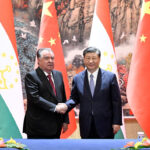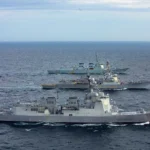The West Philippine Sea incident follows increased Japanese and American support for the Philippine Coast Guard and Navy, with new vessels from Japan and joint U.S.-Philippine patrols on the horizon.
The latest China-Philippines West Philippine Sea spat comes as Manila seeks further assistance and cooperation with its allies, specifically from Japan and the United States. This incident comes on the heels of the Marcos-Kishida visit, which saw discussions of further Japanese-led PCG development, and the announcement of the resumption of joint American-Philippine patrols in the South China Sea.
Last week’s incident on February 6th saw BRP Malapascua (MRRV-4403) of the PCG harassed by China Coast Guard (CCG) vessel 5205 during a resupply mission to the Philippine outpost on Ayungin Shoal. Media released by the PCG show the use of a laser on the CCG side. The official PCG release stated that the laser was “military-grade,” and temporarily blinded the Philippine vessel’s crew. After a series of “unsafe maneuvers” by 5205, BRP Malapascua withdrew and joined BRP Teresa Magbanua (MRRV-9701) to support another resupply mission to other Philippine outposts in the West Philippine Sea.

The PCG also released a previous incident in tandem with the February 6th laser encounter. Occurring in August of 2022, this incident saw the harassment of BRP Teresa Magbanua in a resupply mission to Ayungin Shoal. The CCG deployed a blockade of the West Philippine Sea feature alongside vessels of the China Maritime Militia, in which the CCG vessels 5205 and 5102 and two unidentified CMM vessels, denying access to the shoal for the Philippine ships. A particularly provocative measure was taken by the CCG, as the gun covering for 5205’s main cannon was removed as BRP Teresa Magabnua approached Ayungin Shoal.
As of writing the United States, Japan, Australia, Canada, and Germany have voiced concern/support to the Philippines in regard to the actions taken against the Philippine vessel by China. Meanwhile, China claims that the CCG vessel “upheld China’s sovereignty and maritime order and acted in a professional and restrained way.” The Philippines has lodged a diplomatic protest and summoned the Chinese Ambassador in response.
In both incidents released by the PCG, Japan’s prominence in the support of Philippine maritime security capabilities was seen on the frontline of these West Philippine Sea disputes. The latest incident took place during Philippine president Marcos’ visit to Japan where he and Japanese Prime Minister Kishida touched on Japan’s aid to the PCG and projects going forward. On top of thanking Japan for the training of PCG personnel, the Philippine delegation acknowledged the “concrete” plans for a Japanese-funded PCG support base in Subic Bay. It was also noted that this base’s development could see the basing of the PCG’s Japanese-built Teresa Magbanua-class Multi-Role Response Vessels (MRRV).
Japan enhances Philippine maritime security through the Japan International Cooperation Agency, which facilitates loans to fund projects for the PCG. The most publicized and impactful projects that Japan has provided the Philippines with are the Parola and Teresa Magbanua-class MRRVs. Through the Maritime Safety Capability Improvement Project, phases I and II have provided the PCG with a fleet of 12 brand-new Japanese-built patrol vessels. As seen with the latest incident, these Japanese-built and funded vessels take a frontline role in enforcing Philippine claims in the West Philippine Sea.
The PCG is seeking five more Teresa Magbanua-class MRRVs from Japan and more OPVs from France.
The United States, the Philippines’ longstanding security partner, has also taken a major role in building up the country’s maritime security capabilities. American security assistance to enhance Philippine maritime security is broad, as the U.S. has provided everything from training to the transfer of drones. Now, the U.S. is planning to take a more active role
A resumption of joint Philippine-U.S. Navy patrols was announced earlier this month in tandem with four new Enhanced Defense Cooperation Agreement sites that U.S. forces could use. These joint activities were brought up at the 2nd Philippine Fleet-7th Fleet Staff-to-Staff talks at Subic Bay last week, with “maritime cooperative activities” and “naval aviation activities” being some of the topics the two navies discussed.
American involvement in the PCG may not be as materially prominent as Japan with their patrol vessels, but still makes up a large component of foreign aid to the PCG. Last summer, U.S. officials transferred equipment to the agency during the PCG Fleet’s 15th Anniversary celebration. The ceremony was attended by the U.S. Ambassador to the Philippines MaryKay Carlson, who highlighted U.S. support for the force.
“The PCG is on a promising trajectory, and we are excited to do what we can to help the Coast Guard reach its bold and vital development goals to meet the full array of maritime challenges. From promoting safety to security and to protecting environmental and economic interests.”
Vice President Kamala Harris also emphasized America’s commitment to the force in her visit to Palawan, where she held a speech onboard BRP Teresa Magbanua. Harris also noted how the PCG is benefiting from the Quad’s Indo-Pacific Partnership for Maritime Domain Awareness, a multilateral U.S., Japan, Australia, and India initiative, stating “I am pleased to report that the Philippines is already receiving this stream of data alongside other partners here in Southeast Asia.”
Bilateral cooperation between the U.S. and Japan in assisting the Philippines has taken shape through the Solid Alliance for Peace and Prosperity with Humanity and Integrity on the Rule of law based Engagement (SAPPHIRE). Last October, U.S. and Japan Coast Guards sent teams to the Philippines through the SAPPHIRE framework. Both Coast Guards cooperated with each other in their training of Philippine personnel in various drills, including damage control and boarding operations.
There are also talks of a trilateral between the Philippines, the U.S., and Japan. Marcos also said he would be open to a Visting Forces Agreement with Japan, which would allow Japanese troops to perform more complex activities on Philippine soil, if “it will be of help to the Philippines in terms of protecting our fishermen, protecting our maritime territory,”
Source: Naval News
















